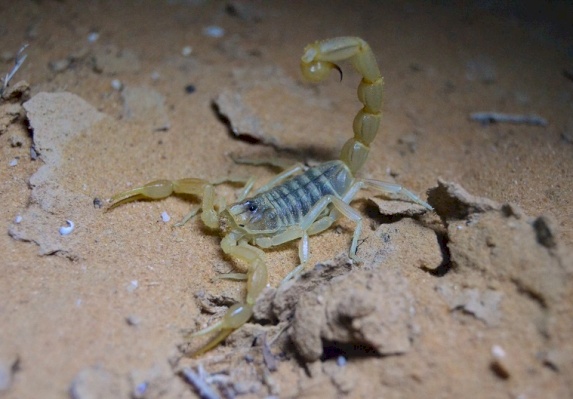Common Yellow Scorpion
Common Yellow Scorpion
/ Buthus occitanus
/ عقرب أصفر شائع
© All rights reserved by www.mahmiyat.ps
| The Common Yellow Scorpion belongs to the Buthidae family in the Scorpiones (scorpions) order, of the Arachnida (arachnids) class. The Common Yellow Scorpion is a relatively medium sized scorpion, that may reach up to 70mm. this scorpion can be found in dense populations within its distribution areas, and considered to be one of the easiest species to be confused with the Deathstalker Scropion, and vice versa. The Common Yellow Scorpion lives under stones and in abandoned burrows of Isopods and scorpions. This species venom is considered to be non-life threatening. The species can be easily identified by its overall yellow coloration and darker, gray, granulated back. The walking legs are partially brighter than the body color. It lacks the dark grey, 5th metasomal (often mistaken as a "tail") segment and has much bulged vesicule, and lacks the five-crested tergites compared to the Deathstalker. Another two unique recognition features are the prosoma ("head") granulates, which creates a special harp-like shape, as well as rough, heavy granulates on the ventral side of the 2nd and 3rd metasomal ("tail") segments, which the Deathstalker do not show. The genus scientific name, "Buthus" was derived to new Latin from Greek word "Bous", which means an ox, or a beef (as grazing). As no etymology provided in description paper, it is probably about "cow stinger" or "swift", in reference to its powerful sting. Its diet, as many other scorpions species, is based on small invertebrates. This scorpion species behavior varies between different specimen. They can be found in many forms of tempers – from hot, to mild and docile. As many other scorpions, they tend to find an escaping trace first in most cases (mainly, excluding of direct touch) - and if kept disturbed, they will sting or hit with the side of their metasoma, as well as runaway while trying to find a new shelter. The Common Yellow Scorpion is distributed in Egypt, Jordan, Sinai, and Palestine. It is not yet clear whether Egyptian areas inhabits different species or not. In Palestine – this species mostly found in arid or southern areas of the country. It can be found on loess, stony deserts, sandy soils and sand dunes. It often found in high dense populations. |

